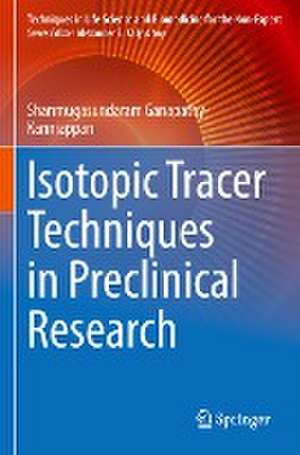Isotopic Tracer Techniques in Preclinical Research: Techniques in Life Science and Biomedicine for the Non-Expert
Autor Shanmugasundaram Ganapathy-Kanniappanen Limba Engleză Paperback – 5 mai 2023
| Toate formatele și edițiile | Preț | Express |
|---|---|---|
| Paperback (1) | 420.13 lei 6-8 săpt. | |
| Springer International Publishing – 5 mai 2023 | 420.13 lei 6-8 săpt. | |
| Hardback (1) | 584.61 lei 6-8 săpt. | |
| Springer International Publishing – 4 mai 2022 | 584.61 lei 6-8 săpt. |
Preț: 420.13 lei
Preț vechi: 442.24 lei
-5% Nou
Puncte Express: 630
Preț estimativ în valută:
80.39€ • 83.93$ • 66.53£
80.39€ • 83.93$ • 66.53£
Carte tipărită la comandă
Livrare economică 04-18 aprilie
Preluare comenzi: 021 569.72.76
Specificații
ISBN-13: 9783030997021
ISBN-10: 3030997022
Pagini: 66
Ilustrații: XIII, 66 p. 19 illus., 8 illus. in color.
Dimensiuni: 155 x 235 mm
Greutate: 0.13 kg
Ediția:1st ed. 2022
Editura: Springer International Publishing
Colecția Springer
Seria Techniques in Life Science and Biomedicine for the Non-Expert
Locul publicării:Cham, Switzerland
ISBN-10: 3030997022
Pagini: 66
Ilustrații: XIII, 66 p. 19 illus., 8 illus. in color.
Dimensiuni: 155 x 235 mm
Greutate: 0.13 kg
Ediția:1st ed. 2022
Editura: Springer International Publishing
Colecția Springer
Seria Techniques in Life Science and Biomedicine for the Non-Expert
Locul publicării:Cham, Switzerland
Cuprins
1. Introduction.- 2. Tracer technique in basic research.- 3. Tracer technique in applied research.- 4. Literature cited
Notă biografică
Shanmugasundaram Ganapathy-Kanniappan holds a Ph.D. degree from the University of Madras, India. In 2006, he joined the Department of Radiology, Johns Hopkins University School of Medicine, as a junior faculty member and was quickly promoted to assistant professor. Before joining the Johns Hopkins, he underwent postdoctoral training in premier institutes such as the National Institute of Immunology (NII, New Delhi, India) and the University of California at Los Angeles (UCLA). His current research interests include metabolic alteration in human pathophysiology and the identification of molecular targets for therapeutic intervention. He has published over 50 articles including original reports, invited reviews, editorials, book chapters, and books (https://www.ncbi.nlm.nih.gov/myncbi/1xKsymd-il85x/bibliography/public/). He is an inventor and coinventor of several patents and a recipient of prestigious fellowships and research awards including funding from private and federal sponsors. He is on the editorial board of peer-reviewed journals and currently serves the journal, Frontiers in Oncology as an associate editor for the section, Cancer Molecular Targets and Therapeutics.
Textul de pe ultima copertă
This book serves as a practical guide and a manual on the application of isotopic tracers in understanding the cellular processes (e.g. molecular interactions, protein synthesis) in growth, development, and disease conditions. The techniques described in the book have been carefully chosen to underscore the role and relevance of isotopic tracers in the identification of molecular targets and mechanisms, and preclinical validation of potential therapeutics. This book is intended to be a valuable resource to non-experts that may include students, researchers, educators/teachers, and others who have an interest to understand the application of isotopic tracers in research. Each chapter includes a background, an outline of the method and underlying principles, and a detailed step-wise protocol. To augment the clarity and intellectual grasp, the chapters also include relevant illustrations and study questions. More importantly, the book covers techniques involving radioactive as well asnon-radioactive tracers to expand the scope of isotopes in preclinical research including basic and applied science.
Caracteristici
Practical, user-friendly compendium of the critical tracer techniques used in basic and preclinical research Useful for both in vitro and in vivo models Methods include radioactive and non-radioactive isotopic tracers employed in basic and applied research Includes detailed examples, step-by-step instructions, and study questions











